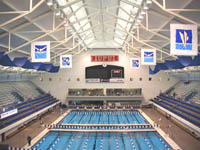Homework and Swimming
I’ve just heard a heart warming story. Lydia, mother of Amy and Liz, has called to say she has been talking to Amy’s math teacher about the amount of homework. Evidently eleven year old Amy is expected to plough through ninety minutes of school homework every night. Lydia explained how difficult it was to program all that homework and swimming and dinner and still make sure Amy got a good night’s sleep. The teacher appears to have understood and has undertaken to reduce Amy’s homework load.
What an enlightened attitude; unfortunately scarce but fortunately not unique. I’ve never understood some school’s fanatical desire to extend the school day well into the night. Teachers who can’t educate the nation’s children between the hours of 8.00am and 3.00pm are pretty bloody poor teachers.
And two Penn State researchers, David P. Baker, Professor of Education and Sociology and Gerald K. LeTendre, Associate Professor of Education agree with me. They have published an interesting book (National Differences, Global Similarities: World Culture and the Future of Schooling) on the subject.
From http://www.physorg.com/ -
Their findings indicate a lack of positive correlation between the amount of homework assigned in a nation and the corresponding level of academic achievement. For example, many countries with the highest scoring students, such as Japan, the Czech Republic and Denmark, have teachers who give little homework. "At the other end of the spectrum, countries with very low average scores - Thailand, Greece, Iran - have teachers who assign a great deal of homework."
"The United States is among the most homework-intensive countries in the world. American students appear to do as much homework as their peers overseas - if not more - but still only score around the international average. Undue focus on homework as a national quick-fix, may lead a country into wasted expenditures of time and energy."
Unfortunately, the message does not seem to be getting through. Since I’ve been in the United States, at least twenty parents have come to me and explained that their son or daughter would not be able to swim for a month because their math or English or science grades were not what they expected. I’ve always said, “Oh that’s fine,” knowing full well that in a month the academic problem would still exist and they would have added a swimming one as well. They just do not appreciate that more time is not the solution. Better use of time is where the answer lies. In case anyone feels I’m picking unfairly on the United States, I’ve heard the same “time off swimming to study” argument plenty of times in New Zealand.
The by-product of this academic enthusiasm is the same as the by-product of swimming enthusiasm: burn out. The art of peaking at the right time requires just as much skill in the class room as it does in the swimming pool. Swimming has more than its fair share of coaches who push for peak results at High School without a thought for the long term consequences. Teachers too demand peak High School grades even if it means their charges have little application or enthusiasm left for university.
I’ve coached several international athletes during their Elementary and High School years. In all cases I’ve promoted the idea of reducing their academic load and application as much as possible. For eight years Jane Copland and Nichola Chellingworth attended one of New Zealand’s best and most academic private schools. The principal was a fine and somewhat awe-inspiring woman called Jennifer Button. She ran a tight and disciplined ship. No compromise of academic standards was entertained in her school. But do you know what, Miss Button, whose knowledge of sport was and probably still is zero, never once objected to Jane and Nichola taking a week off school to go to the National Championships or three weeks off to tour the European World Cup Meets. She may have known little about sport but she knew full well the meaning of excellence.
Before she came to the United States, Jane completed her High School education at Hastings Girls' High School. Geraldine Travers was the principal there and Jane was lucky again. She was allowed time off school to practice and sleep and to travel New Zealand and the world swimming; late or non-existent homework was ignored. Many would consider it all an educational travesty. But did it work?
I guess so: both girls were national champions, both swam in the Pan Pacific Games and the like. Both graduated from university with good grades.
So when it’s late and there’s still Elementary School homework to do, or you want two weeks off school to go swim in a championship meet, my advice is forget the homework, go to bed and swim the meet. Your university career will only improve.

